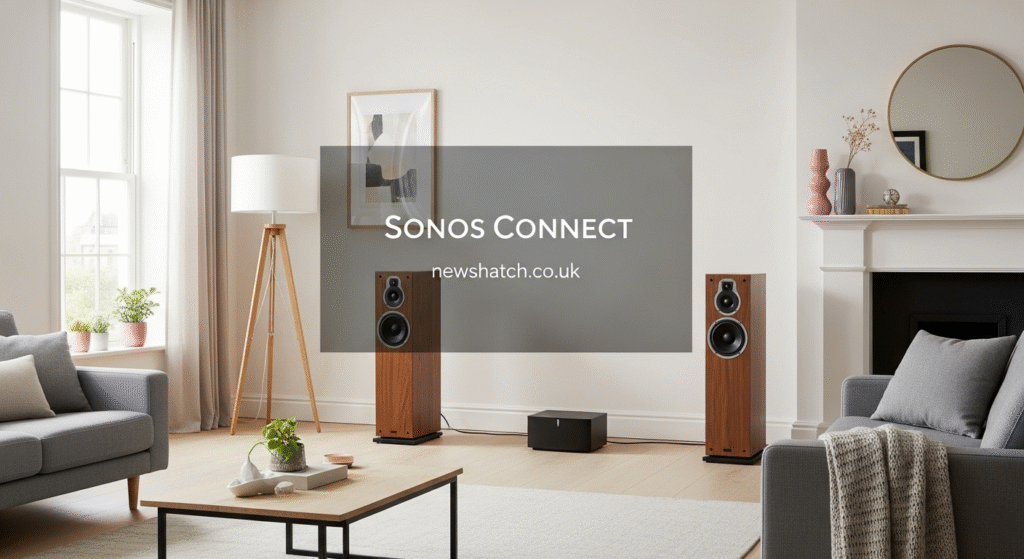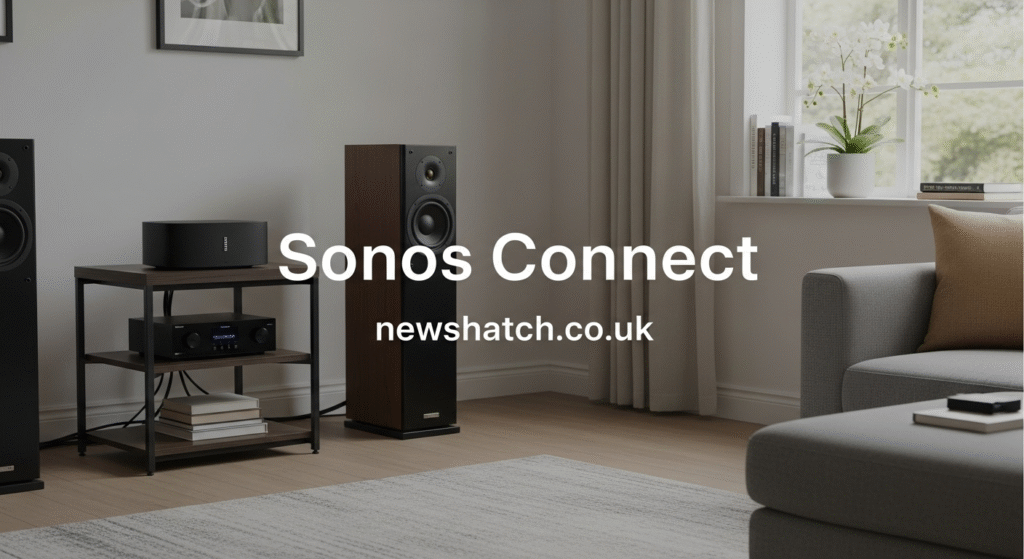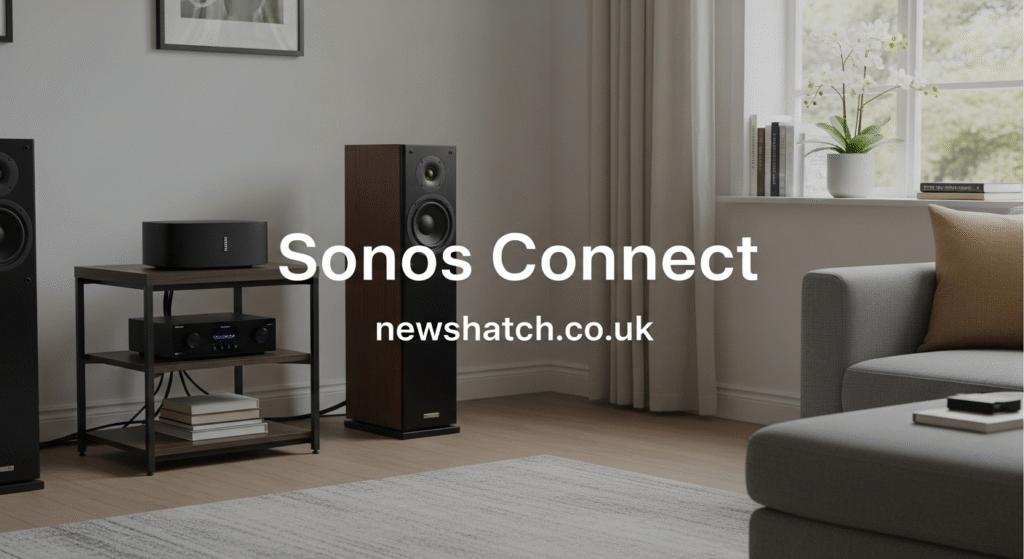Introduction
If you’ve ever dreamed of turning your old stereo into a modern wireless powerhouse, you’ve probably come across Sonos Connect. This little device promises to bridge the gap between traditional audio setups and the smart, wireless world of today. But here’s the question: does it still make sense to buy one in 2025?
You’re not alone if you’re torn. On one hand, the idea of giving your classic speakers new life without ditching them is exciting. On the other hand, Sonos Connect has been around for years, and Sonos now offers newer models. So, is it worth your money? Or should you skip it and look for an alternative?
In this guide, we’ll break down everything you need to know about Sonos Connect—its features, setup process, pros and cons, how it compares to newer Sonos products, and even some alternatives. By the end, you’ll know if Sonos Connect is still a smart buy for your home audio system—or if you should move on.
What is Sonos Connect?
At its core, Sonos Connect is a wireless streaming component. Think of it as the middleman that connects your existing speakers, amplifiers, or home theater system to the Sonos ecosystem.
- It doesn’t come with built-in speakers.
- Instead, it plugs into your stereo or AV receiver.
- Once connected, you can stream music from your phone, computer, or the internet directly to your existing sound system.
The magic of Sonos Connect lies in its ability to modernize older audio setups. If you already own high-quality speakers you love, you don’t need to replace them. Instead, Connect makes them smart and wireless.
Why People Loved Sonos Connect
Before diving into the pros and cons, let’s look at why Sonos Connect was such a big deal when it launched.
1. Wireless Streaming
You could suddenly stream Spotify, Apple Music, Pandora, or your personal library without running extra cables.
2. Multi-Room Audio
Sonos Connect allowed people to sync music across multiple rooms—something that felt futuristic at the time.
3. Easy App Control
The Sonos app turned your phone into a remote. You could adjust volume, change tracks, or group rooms without leaving the couch.
4. Future-Proofing Old Gear
Instead of throwing out expensive speakers, Connect gave them a second life.
If you owned a high-end stereo, Sonos Connect was an easy “yes.”
The Downsides of Sonos Connect
Of course, not everything about Sonos Connect is perfect.
- Pricey for what it is – It cost more than some full Sonos speakers.
- No built-in amplification – You still needed an amp or powered speakers.
- Not the newest option anymore – Sonos has replaced it with newer devices.
- Limited hi-res audio support – Audiophiles sometimes found it lacking.
So while Connect made sense years ago, today’s buyers need to weigh these drawbacks carefully.

How Does Sonos Connect Work?
Understanding how it works will help you decide if it fits your setup.
Step 1: Connect It to Your Stereo
You plug Sonos Connect into your stereo system using analog (RCA) or digital (coaxial/optical) outputs.
Step 2: Connect It to Wi-Fi
Once powered on, it connects to your Wi-Fi network through the Sonos app.
Step 3: Control with the App
You can stream music, adjust settings, and group it with other Sonos products.
It’s that simple—no messy wires, no complicated setup.
Sonos Connect vs Sonos Port
One of the most common questions is: should you buy Sonos Connect or Sonos Port?
Sonos Port (the successor)
- Newer design
- Improved sound quality
- Better power management
- Still connects old speakers to Sonos
Key Difference
Sonos Connect is discontinued, while Sonos Port is the current replacement. If you want the latest software updates and better audio, the Port is the better choice.
Who Should Consider Sonos Connect?
If you find a Sonos Connect at a good price (especially second-hand), it can still be worth it for:
- People with high-quality traditional speakers
- Anyone who wants to join the Sonos ecosystem on a budget
- Homes that don’t need hi-res streaming but want wireless control
But if you want long-term support, Port is the safer bet.
Pros and Cons of Sonos Connect
Pros
- Simple setup
- Great for retrofitting existing speakers
- Full Sonos ecosystem access
- Multi-room audio
Cons
- Discontinued model
- No built-in amp
- Expensive compared to alternatives
- Not the best for audiophiles
Alternatives to Sonos Connect
If you’re not sold, you do have other choices.
- Sonos Port – The official replacement.
- Bluesound Node – Popular with audiophiles, supports hi-res audio.
- Yamaha MusicCast – Similar ecosystem features.
- Amazon Echo Link – Budget-friendly streaming bridge.
- DIY Raspberry Pi streamers – A geeky but cheap solution.
How to Set Up Sonos Connect
Setting it up is easier than you might think.
- Plug Sonos Connect into your stereo or receiver.
- Connect it to power.
- Download the Sonos app.
- Follow the in-app instructions to connect to Wi-Fi.
- Start streaming music.
In under 10 minutes, your old stereo can become smart.
Sonos Connect for Home Theaters
One underrated use of Sonos Connect was in home theater setups. You could connect it to an AV receiver and stream TV audio through the Sonos system. While not as seamless as Sonos Arc or Beam, it gave home theater enthusiasts flexibility.
Is Sonos Connect Worth It in 2025?
Here’s the honest truth.
If you already own one and it works—keep using it. It’s still a reliable way to stream music. If you’re thinking about buying one used, weigh the price against newer options.
But if you’re buying brand-new? The Sonos Port or even other modern streamers are usually the better deal.
Quick Tips Before Buying
- Check if the seller offers warranty if you’re buying used.
- Compare prices with the Sonos Port.
- Don’t buy if hi-res audio is your top priority.
- Consider your long-term upgrade path.

Conclusion
The Sonos Connect was a game-changer when it launched, and even today, it still has a role for certain users. If you love your old speakers and just want them to join the wireless world, it’s a smart way to modernize them—especially if you find one at a reasonable price.
But for most buyers in 2025, the Sonos Port or other alternatives make more sense. Think about your budget, audio needs, and how long you want the system to last.
So, would you still buy a Sonos Connect today—or is it time to move on?
FAQs About Sonos Connect
1. Is Sonos Connect discontinued?
Yes, Sonos discontinued it and replaced it with the Sonos Port.
2. Does Sonos Connect have an amplifier?
No, it needs an external amp or powered speakers.
3. Can I still use Sonos Connect in 2025?
Yes, as long as it works, but future software updates may be limited.
4. What’s the difference between Sonos Connect and Port?
Port is newer, has better sound quality, and receives ongoing support.
5. Does Sonos Connect support hi-res audio?
Not really—it supports CD-quality but not the highest-resolution formats.
6. Can Sonos Connect work without Wi-Fi?
It primarily needs Wi-Fi, but you can use Ethernet if available.
7. Can I use Sonos Connect with Alexa or Google Assistant?
Indirectly, yes, if paired with compatible devices.
8. Is it worth buying Sonos Connect used?
Only if you find it much cheaper than a new Sonos Port.
9. Does Sonos Connect support AirPlay 2?
No, that feature came with newer Sonos devices.
10. Can I connect a turntable to Sonos Connect?
Yes, if your turntable has a preamp and connects via line-in.
Also Read: Click Here
